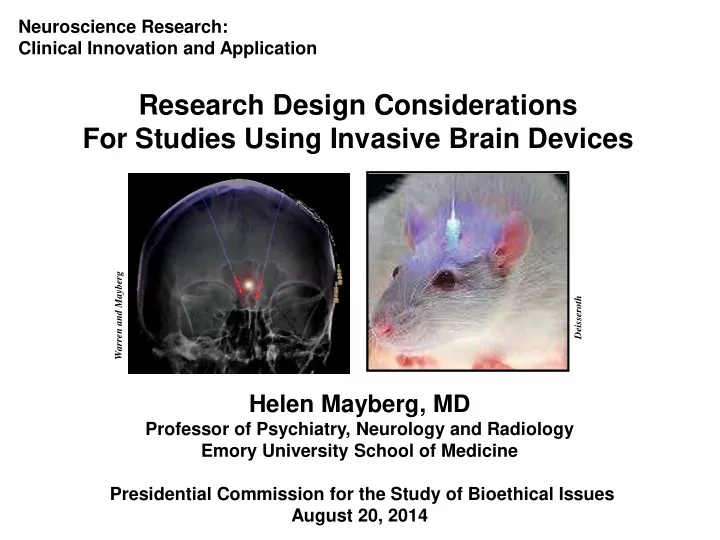

Neuroscience Research: Clinical Innovation and Application Research Design Considerations For Studies Using Invasive Brain Devices Warren and Mayberg Deisseroth Helen Mayberg, MD Professor of Psychiatry, Neurology and Radiology Emory University School of Medicine Presidential Commission for the Study of Bioethical Issues August 20, 2014
Disclosures Grant Support: NIMH, NARSAD, Dana Foundation, Stanley Medical Research Institute, Woodruff Fund, Hope for Depression Research Foundation Off-Label Use of Devices: DBS electrodes/pulse generators 1. Medtronic Inc. (UT, Emory) 2. St. Jude Medical, Inc. (Emory) Emory DBS studies: FDA IDE: G060028 (PI: HM), G130107 (PI: HM) Clinicaltrials.gov ID#: NCT00367003, NCT01984710 research devices donated by SJM and Medtronic Patent: US2005/0033379A1 (Andres Lozano, co-inventor) issued March 2008, St. Jude Medical Inc, assignee Consultant: St Jude Medical Inc / Neuromodulation Division
Focal Modulation of Brain Circuits why, where, how, who ? ? ? device implant target nodes diffusion MRI connectome circuit of interest Movement Mood/Motivation Memory Seizures, TBI depression, OCD, Tremor, Parkinson’s dz, Alzheimer’s dz addiction, PTSD dystonia, stroke rehab
Design of Invasive Studies for Any Condition Mechanics • brain target to stimulate • behavioral endpoint • appropriate patients • the “illness” circuit • response pathway(s) • what brain changes are critical • predictive biomarkers • metrics of target engagement • cycle of test, analyze, refine Caveat: Goals and Risk/Benefit tolerance will vary by diagnosis
Deep Brain Stimulation (DBS) as Prototype Strategy based on pathology of interest • specific symptoms: reverse, maintain (tremor, dystonia, depression) • degenerative disorder: slow progression (Parkinson’s, Alzheimer’s) • acquired lesions: facilitate plasticity, enable rehab (stroke, PTSD, OCD) • episodic disorders: prevent, interrupt (seizures, panic, craving) • developmental disorders: schizophrenia, autism (?) Exceptional needs for implanted devices • risk of surgery weighed against risk of disorder • sustained long-term benefit necessary to justify risk, cost • options for modifications based on new data/knowledge once implanted Defining Outcomes • full syndrome or specific symptoms (single, multiple targets) • better or well but sustained and how long • cure versus slowed progression of underlying disease • DBS alone or as a facilitator of other methods (Rehab, CBT) • target engagement, biometrics, patient center quality of life
Perspectives: Academia – Industry – FDA • Physician sponsored IDEs: small trials, informative MOA studies, steady progress • Basic scientists/engineers: translational studies, new tool development ongoing • NIH/DARPA: R21/R33/U01 RFAs; Subnets, RAM initiatives --growth areas • Industry: Recent failures of pivotal trials require rethinking approach Study design going forward • what is threshold to proceed to a new clinical trial? • is an animal model necessary? • common or different standards for different diseases? • novel outcome measures: biometrics, patient centered? • novel designs: flexibility for refinement, modifications as data evolves Transition: experiment to treatment 1. • when is a study no longer a study? perpetual IDE? • access to a device/intervention if trial halted but it works for individual • liability, responsibility, cost? • fast track for intractable symptoms/risk for self harm
Perspective: Patients “In depression, faith in deliverance, in ultimate restoration, is absent. The pain is unrelenting, and what makes the condition intolerable is the foreknowledge that no remedy will come— not in a day, an hour, a month, or a minute. William Styron, 1991 If its safe, why should I have to wait for a pivotal trial? How good is good enough for me to have access? I have the money and I am willing to take the risk… What do I have to lose? Culture shift needed to facilitate Academic-Industry-FDA-Patient Collaborative Partnerships
Summary 1. Must know the biology: will inform where, how and who 2. Multiple outcomes needed: quantitative biometrics AND patient centered 3. Methods are NOT turn-key: adaptive designs that build in flexibly for modifications 4. New standards for defining success and failure: all or none may not be meaningful 5. New avenues for patient access beyond RCT/HDE: ensure 1-4 + safety
Recommend
More recommend